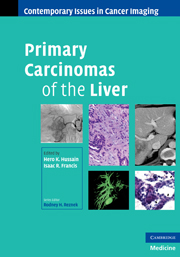Book contents
- Frontmatter
- Contents
- Contributors
- Series foreword
- Preface to Primary Carcinomas of the Liver
- 1 Epidemiology of hepatocellular carcinoma and cholangiocarcinoma
- 2 Surveillance and screening for hepatocellular carcinoma
- 3 Pathology of hepatocellular carcinoma, cholangiocarcinoma, and combined hepatocellular-cholangiocarcinoma
- 4 Radiological diagnosis of hepatocellular carcinoma
- 5 Staging of hepatocellular carcinoma
- 6 Surgical treatment of hepatocellular carcinoma: resection and transplantation
- 7 Non-surgical treatment of hepatocellular carcinoma
- 7.1 Regional therapies for treatment of intermediate-stage hepatocellular carcinoma
- 7.2 Systemic therapies for advanced hepatocellular carcinoma
- 8 Radiological identification of residual and recurrent hepatocellular carcinoma
- 9 Radiological diagnosis of cholangiocarcinoma
- 10 Staging of cholangiocarcinoma
- 11 Treatment of cholangiocarcinoma
- 12 Uncommon hepatic tumors
- Index
- Color plates
- References
7.2 - Systemic therapies for advanced hepatocellular carcinoma
from 7 - Non-surgical treatment of hepatocellular carcinoma
Published online by Cambridge University Press: 04 August 2010
- Frontmatter
- Contents
- Contributors
- Series foreword
- Preface to Primary Carcinomas of the Liver
- 1 Epidemiology of hepatocellular carcinoma and cholangiocarcinoma
- 2 Surveillance and screening for hepatocellular carcinoma
- 3 Pathology of hepatocellular carcinoma, cholangiocarcinoma, and combined hepatocellular-cholangiocarcinoma
- 4 Radiological diagnosis of hepatocellular carcinoma
- 5 Staging of hepatocellular carcinoma
- 6 Surgical treatment of hepatocellular carcinoma: resection and transplantation
- 7 Non-surgical treatment of hepatocellular carcinoma
- 7.1 Regional therapies for treatment of intermediate-stage hepatocellular carcinoma
- 7.2 Systemic therapies for advanced hepatocellular carcinoma
- 8 Radiological identification of residual and recurrent hepatocellular carcinoma
- 9 Radiological diagnosis of cholangiocarcinoma
- 10 Staging of cholangiocarcinoma
- 11 Treatment of cholangiocarcinoma
- 12 Uncommon hepatic tumors
- Index
- Color plates
- References
Summary
Introduction
Historically, radiotherapy (RT) had an extremely limited role in the treatment of liver malignancies due to the low tolerance of the whole liver to radiation. The risk of radiation-induced liver disease (RILD) limits the dose that can be safely delivered to the whole liver to only 30–35 Gy in 2-Gy fractions, a dose that is well below the doses needed to eradicate solid tumors. The development of three-dimensional conformal RT (3-D CRT) allows the delivery of higher radiation doses to the tumor while minimizing the dose to the surrounding uninvolved liver. Advances in tumor targeting via improved diagnostic imaging, techniques to control or account for motion of the liver due to respiration, and the use of image guidance enable us to further escalate the dose to the tumor without increasing the toxicity.
Studies using modern RT techniques and higher doses for treating hepatocellular carcinoma (HCC) have shown encouraging results. The concepts of liver RT, the techniques, and the available clinical data will be reviewed in this chapter.
Liver tolerance to radiation
RILD may develop between 2 weeks to 4 months after hepatic irradiation and is characterized by anicteric hepatomegaly, ascites, and impaired liver function tests, occurring in the absence of disease progression. Serum alkaline phosphatase is typically markedly elevated, with only moderate elevations of liver transaminases and little or no increase in bilirubin.
- Type
- Chapter
- Information
- Primary Carcinomas of the Liver , pp. 97 - 121Publisher: Cambridge University PressPrint publication year: 2009



